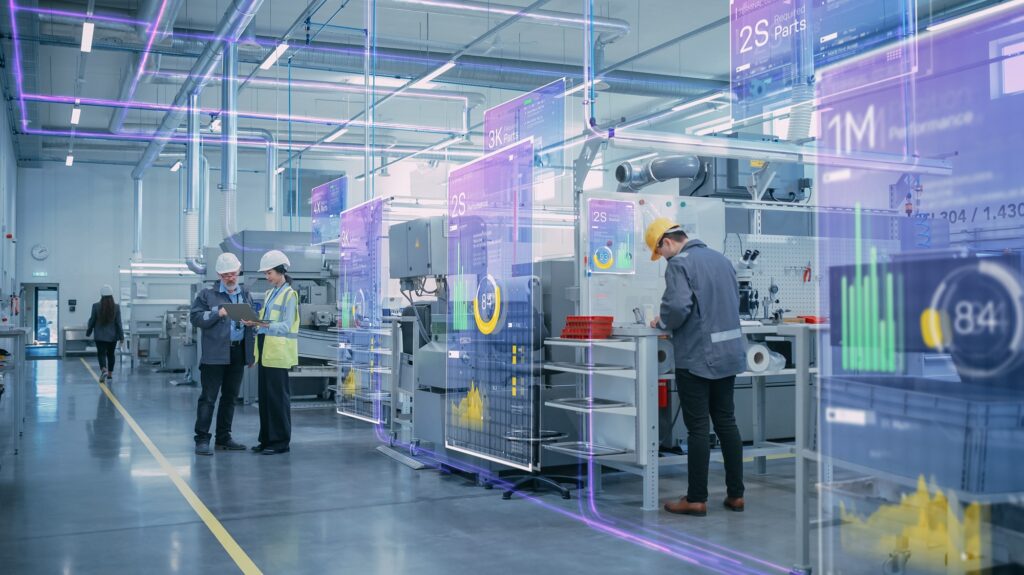Augmented Reality (AR) in the manufacturing industry refers to the use of digital technology to overlay virtual information, objects, or images onto the physical environment of a manufacturing facility.
The Basics of Augmented Reality (AR)

Definition of Augmented Reality for Manufacturing Accuracy
You’ve probably heard the term augmented reality, and while we understand what it means from an entertainment perspective, what is its role in a manufacturing work environment?
Often assimilated as a strange term in science fiction movies, augmented reality is now closer to everyday life and gradually evolving into the industrial world.
Augmented reality (AR) technology integrates virtual elements in 3D (in real-time) within a real environment. The principle is to combine the virtual and the real worlds digitally to provide perfect integration.
What is the difference between augmented reality and virtual reality?
Before continuing, it is important to understand the difference between all the different existing technologies: mixed reality, virtual or augmented reality, so many terms for which we will provide some explanations.
What is Augmented Reality?
While we have already covered this concept previously, it’s important to keep it in mind as we highlight the difference with the term virtual reality (or VR).
Here we don’t just superimpose virtual information on an image but integrate synthetic information in the real environment (we consider that an element can hide certain information, etc.).
What is Virtual Reality?
Conversely, virtual reality (VR) immerses a user in reality entirely generated and assisted by a computer. Immersion is typically enabled by hardware devices such as VR goggles, virtual reality headsets, or walled rooms with video screens to fill the user’s entire field of view. VR brings an immersion in a 100% synthetic/digital environment.
Augmented Virtual Reality or Augmented Virtuality
What’s behind this new term? It is nothing more or less than another way of characterizing virtual data. Here, digital data is not displayed in a real environment but the opposite.
One or more pieces of information from the real world is imported and displayed in a digital environment. For example, when a user equipped with a virtual reality helmet sees his own hands appear while immersed in a digital world and interacts with it.
What about mixed reality?
Mixed reality is a fusion between real and virtual worlds where digital and physical objects (e.g. mixed reality headsets) cohabit to create new environments.
Mixed reality is differentiated by a very specific interaction of digital content with physical space. Nevertheless, it remains a dimension that covers all forms of augmented reality, that is, all degrees of fusion between the real and virtual worlds.
To summarize, augmented reality brings digital content directly into the real world, virtual reality displays physical information in a digital environment, and mixed reality is similar to augmented reality.
How does Augmented Reality work?
Augmented reality adds virtual information (texts, animations, images, 3D models, etc.) into the real environment. To do this, augmented reality inlays this information into the user’s environment in different ways:
- Insertion of these elements into a video stream viewed on a screen or tablet. The latter then becomes a window into the world with virtual information embedded.
- Displays on lenses in the user’s vision (Hololens example)
- Use of a projector to display information directly on the object.
However, this information must be embedded in the right place and it’s necessary to know the location where it resides. For this purpose, we use one or more sensors to ensure the data location such as:
- Color camera
- Depth sensor
- Inertial unit
- GPS
Augmented reality solutions are therefore distinguished by means of restitution, the means of capture, and the way they use the latter to localize themselves.
The solution’s first category aims to locate itself in relation to the global environment. For example, using cell phone sensors (GPS, inertial navigation system, cameras, etc.) allows one to locate oneself outdoors (PokemonGo, GoogleMaps or LiveView). It displays information that remains stable in relation to the world. In the same way, other solutions allow us to locate ourselves indoors and to place elements that will remain anchored and stable in our environment.
Enjoyed this article? Read the second article in this series on How to Choose the Right Augmented Reality Solution.
Watch the video to discover more:

